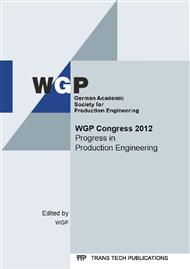[1]
Klocke, F.; Schuh, G.; Brecher, C.; Schmitt, R.: Excellence in Production, Wissenschaftsverlag des Instituts für Industriekommunikation und Fachmedien an der RWTH Aachen, WZL RWTH Aachen, Aachen, (2007).
DOI: 10.17973/mmsj.2021_7_2021057
Google Scholar
[2]
Shi, X.; Chen, J.; Peng, Y.; Ruan, X.: A new approach of die shape optimization for sheet metal forming processes. Journal of Materials Processing Technology 1, 2004, p.35–42.
DOI: 10.1016/j.jmatprotec.2004.02.033
Google Scholar
[3]
Engel, U.: Prediction of tool failure from a probabilistic point of view, Journal of Materials Processing Technology 42, 1994, p.1–13.
DOI: 10.1016/0924-0136(94)90072-8
Google Scholar
[4]
Blum, C.; Roli, A.: Metaheuristics in combinatorial optimization: Overview and conceptual comparison, ACM Comput. Surv. 3, 2003, p.268–308.
DOI: 10.1145/937503.937505
Google Scholar
[5]
Altan, T.; Vazquez, V.: Numerical Process Simulation for Tool and Process Design in Bulk Metal Forming, CIRP Annals – Manufacturing Technology 2, 1996, p.599–615.
DOI: 10.1016/s0007-8506(07)60514-9
Google Scholar
[6]
Roll, K.: Simulation of Sheet Metal Forming – Necessary developments in the future, In: LS-Dyna Anwenderforum, 2008, p.59–68.
Google Scholar
[7]
Roy, R.; Hinduja, S.; Teti, R.: Recent advances in engineering design optimisation: Challenges and future trends, CIRP Annals - Manufacturing Technology 2, 2008, p.697–715.
DOI: 10.1016/j.cirp.2008.09.007
Google Scholar
[8]
Liang, J.J.; Qin, A.K.; Suganthan, P.N.; Baskar, S.: Comprehensive learning particle swarm optimizer for global optimization of multimodal functions, Evolutionary Computation, IEEE Transactions, 2006, p.281–295.
DOI: 10.1109/tevc.2005.857610
Google Scholar
[9]
Hortig D.; Schmoeckel, D.: Analysis of local loads on the draw die profile with regard to wear using the FEM and experimental investigations, Journal. of Materials Processing Technology. 1, 2001, p.153–158.
DOI: 10.1016/s0924-0136(01)00757-9
Google Scholar
[10]
Clausen, P.M.; Pedersen, C.D.W.: Non-Parametric Large Scale Structural Optimization for Industrial Applications, III European Conference on Computational Mechanics, Solids, Structures and Coupled Problems in Engineering, C.A. Mota Soares et. al. (eds. ), Lisbon, Portugal, 5–8 June 2006, p.1.
DOI: 10.1007/1-4020-5370-3_482
Google Scholar
[11]
Harksen, S.; Glaeser, T.; Bleck, W.; Klocke, F.: Beurteilung von Temperaturwechsel und mechanischem Verschleiß auf duplexbehandeltem Warmarbeitsstahl. Tool steels – deciding factor in worldwide production. Vol. 1. Tool 09, Proceedings of the 8th International Tooling Conference, 8ITC, Mainz, 02. 06. –04. 06. 2009. RWTH Aachen (2009).
Google Scholar
[12]
Amende, W.; Oberflächenbehandlung mit Laserstrahlung in H. Treiber: Der Laser in der Fertigungstechnik, Hoppenstedt Technik, Darmstadt (1990).
Google Scholar
[13]
König, W.; Roznoki, L.; Schmitz-Justen, Cl; Treppe, F: Oberflächenveredeln mit Laserstrahlung, Laser and Optoelektronik 20, Nr. 2 (1988).
Google Scholar
[14]
Klocke, F.; Scheller, D.: Process monitoring in laser surface treatment operations with reflection and temperature measurement, Production Engineering, München volume 4 (1997).
Google Scholar
[15]
Vilar, R.: Laser Alloying and Laser Cladding, Deparamento de Engenharia de Materiais, Instituto Superior Tecnico; Materials Science Forum (Volume 301), Lasers in Materials Science, pp.229-252.
DOI: 10.4028/www.scientific.net/msf.301.229
Google Scholar
[16]
Partes K.: Analytical model of the catchment efficiency in high speed laser cladding. (2009) Surf. Coat. Technol. doi: 10. 1016/j. surfcoat. 2009. 07. 041.
Google Scholar
[17]
Zienkiewicz, O.C.; Kelly, D.W.; Bettess, P.: The coupling of the finite element method and boundary solution procedures. International Journal for Numerical Methods in Engineering 2, 1977, p.355–375.
DOI: 10.1002/nme.1620110210
Google Scholar
[18]
Klocke, F.; Bäcker, V.; Feldhaus, B.; Zeppenfeld, C.; Rjasanow, S.; Grzhibovskis, R.: Coupled FE/BE-Analysis of the Deep Rolling Process, Advanced Technology of Plasticity, 2008, p.666–671.
Google Scholar
[19]
Bäcker, V.; Klocke, F.; Wegner, H.; Timmer, A.; Grzhibovskis, R.; Rjasanow, S.: Analysis of the deep rolling process on turbine blades using the FEM/BEM-coupling, IOP Conference Series: Materials Science and Engineering, 2010, pp.121-134.
DOI: 10.1088/1757-899x/10/1/012134
Google Scholar
[20]
Bäcker, V.; Klocke, F.; Timmer, A.; Mattfeld, P.; Schongen, F.; Grzhibovskis, R.; Rjasanow, S.: Time Efficient Numerical Tool Optimization for Wear Reduction in Deep Drawing. In: Proceedings of 10th Int. Conf. Techn. Plast., ICTP. Aachen, September 25. -30. 2011. Düsseldorf: Stahleisen, 2011, S. 390-395.
DOI: 10.4028/www.scientific.net/kem.554-557.317
Google Scholar
[21]
Bäcker, V.; Numerical Tool Optimization in Deep Drawing. Diss. RWTH Aachen, (2011).
Google Scholar


